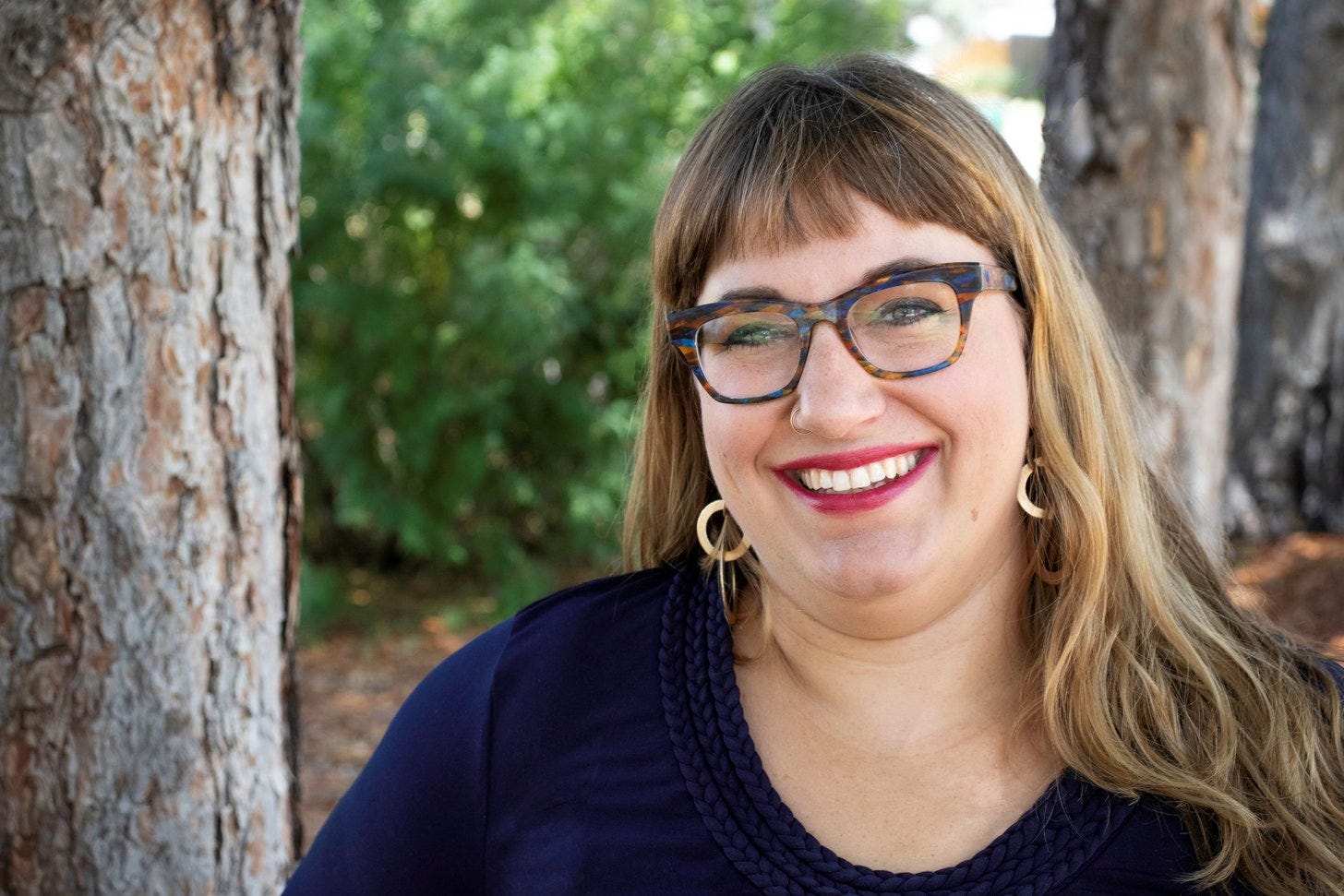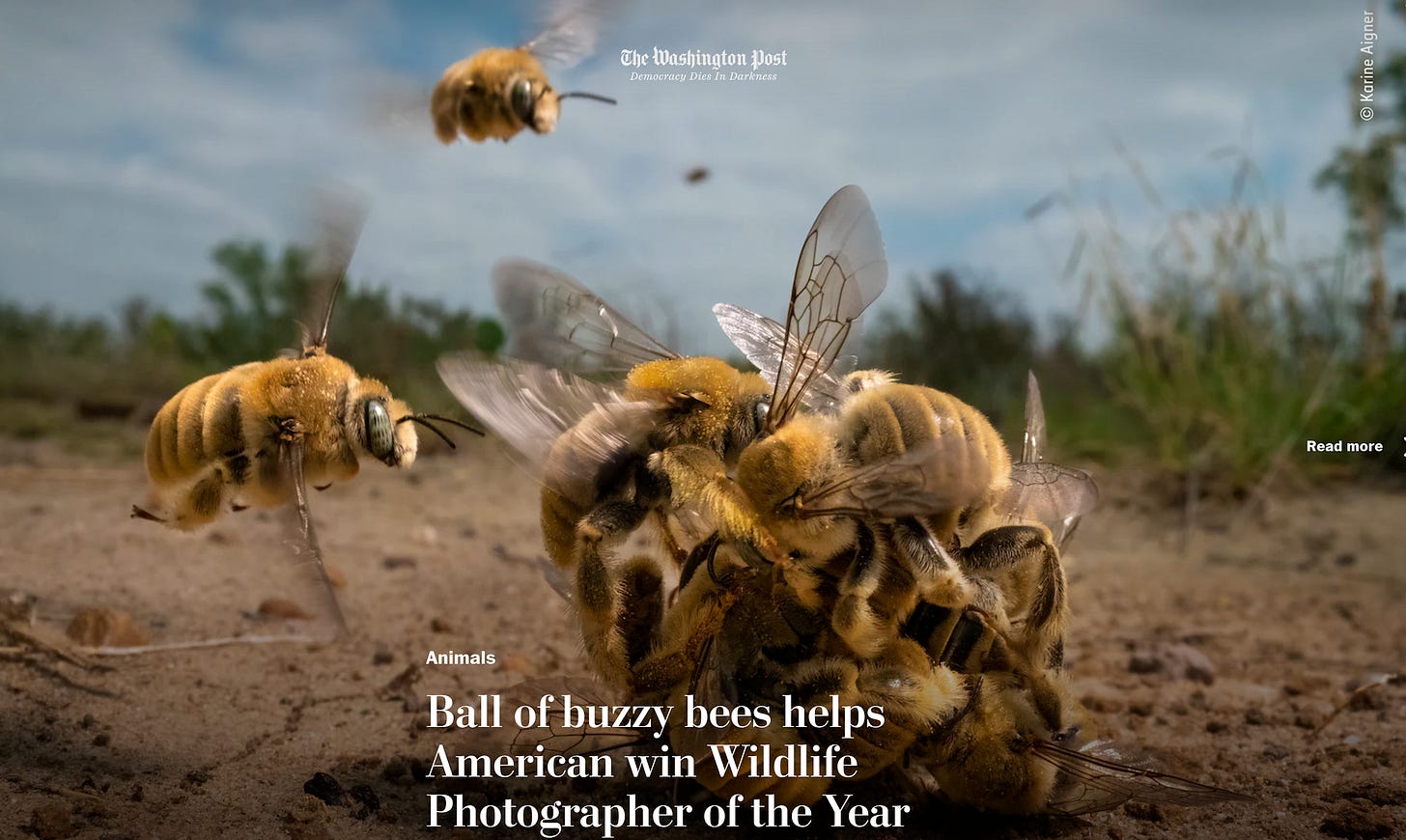The Empathy List #90: This Land is Not My Land
Indigenous Peoples' Day is a Chance to Repent
If you enjoy this newsletter, would you consider forwarding it to a friend?
Hello friend, Liz here.
Driving around Colorado, you might notice Colorado residents have a thing for Jeeps, Subarus and trucks. But we also have a cowboy sort of pride in our under-appreciated state as exemplified by a popular bumper sticker—one you’ll see everywhere you turn in Colorado. Actually, this bumper sticker could be interpreted as a middle finger to all of us who didn’t grow up here. If you drive on our highways, stop at a red light, pull into a campsite, the bumper sticker will be there, too.
The bumper sticker copies the state’s license plate imagery except for one notable difference: instead of the DMV numbers and letters, the word “NATIVE” is inscribed in all caps.
Several ironies accompany this beloved state merch: first, the guy who came up with the product in the ‘80s is from Utah… which would make him a “transplant,” according to a Colorado “native” definition.
But more troubling? Almost no one who claims the moniker “native” is in any true sense “native.” Sure, those brash enough to claim themselves to be “native” might have attended elementary school in the foothills. But most are Anglo-Europeans whose ancestors seized the land from indigenous tribes who got here first.
The true natives in my state are actually the Cheyenne and Arapaho (and other tribal nations) who roamed the plains of Colorado for generations and centuries before my ancestors ever knew this continent existed at all.1
If you enjoy my emails, would you forward this one to a friend?
Which brings me to the point of this email: I want to take this Indigenous peoples’ day—which we celebrated nationally on this Monday, October 10—to reflect.
As a white, transplant Coloradan, I want to consider how I do not belong to this land at all.
And I want to repent of the ways my ancestors abused its previous inhabitants.
**TRIGGER WARNING: I’m talking about violence against indigenous peoples in this newsletter.**
But before I get into repentance or reparations or any BIG BUTTON r-words, I want to dwell on a single story of harm against indigenous Coloradans. This event occurred 150 miles south and east of my house in the bottom corner of my state.
I’m talking about the Sand Creek Massacre.2
Have you ever heard the account? The details are gruesome but worth recounting so that there’s no waffling about who’s to blame for what happened.
Here’s the gist: It’s November 1864. The Civil war has been wrapping up and Anglo-Americans have begun to stretch into western territories. This migration of Europeans into the west led to increased conflict with local tribes.
So in the summer 1864 when a white family in Denver is killed, no surprise that the crime is blamed on raiding Arapaho or Cheyenne warriors. (Who knows if they actually perpetuated any crime at all?)
Considering our current American xenophobia, it’s not hard for me to imagine the rising level of fear and frenzy that accompanied these conflicts between indigenous folks and Europeans, nor is it a stretch to see how a very particular racism could have occurred as a result.
Which leads us to the next part of the story: how Colorado’s governor at the time, Governor Evans, commissioned Colonel Chivington to keep Indian resistance in check in the region. Chivington was commissioned to run a local militia whose aim was to intimidate—and perhaps punish—local indigenous people for not issuing a full-throated welcome to the invaders.
A bit about the leader of this militia: before joining the north’s crusade against the South, Chivington had been a minister who preached the abolition of slavery by any means. (Of course he was a minister! Why are the bad guys always ministers?)
Yet Chivington was hungry for glory. He wasn’t content to preach, he wanted to fight. So he enlisted with the Union which made him a war hero. His merits during the north and south conflict led to an appointment to lead his very own regiment at home in Colorado.
Chivington’s regiment was enlisted for 100 days total, but saw no action. That must have made their colonel itchy because he set out on the last day of his regiment’s enlistment (day 99)—the date was November 29, 1864—and his 700-man troupe charged toward a remote Cheyenne village of 130 lodges on the banks of the Sand Creek watercourse. Perhaps he believed he was headed toward a war camp or that, as some current detractors have claimed, that these Cheyenne were sheltering “traitors.”
Regardless, Chivington described later that his men fought and killed hundreds of Cheyenne warriors in the battle. He described it as a near “annihilation of the entire tribe.” And his superiors celebrated his victory when his crew arrived home with the scalps of the defeated people in hand.
…yet some of Chivington’s men, such as Captain Silas Soule, rejected the attack. He ordered his men not to participate, in violation of his colonel’s orders, because he saw it as a betrayal of peaceful allies.3
This was because the Cheyenne chief over that village, Black Kettle, was known in the region as a peacemaker. In fact, a few months before, Black Kettle had sought refuge at a nearby U.S. fort in order to clearly identify himself and his tribe as peaceful with the white authorities there. Those authorities had communicated to Black Kettle that due to his obliging actions, he’d be under the protection of the U.S. government and that the U.S. no longer considered he or his people a threat.
So on that day in Sand Creek, as an American calvary approached unannounced, Soule reported that Black Kettle had raised an American flag from his tent. Likewise, he urged others in the camp to wave white flags alongside him.
Yet even with these clear symbols of friendship, the soldiers didn’t stop their advance. The flags didn’t work and neither did “hundreds of women and children …coming towards us, …getting on their knees for mercy,” as Soule described later.
These humiliations actually made the deaths of these Cheyenne faster as the soldiers took their opportunity to shoot these tribe members while on the ground. Then, they mutilated their bodies, taking home body parts as prizes—not only scalps, but also “ears and privates,” too. Then they burned the village for good measure.
And this done “by men professing to be civilized” (Soule’s words) and whose leader professed to be a follower of Christ.
That day, the American soldiers massacred 200 Cheyenne, only 60 of whom were soldiers. The majority dead were women, children and the elderly.
Jesus Christ, have mercy.
Surprisingly, Soule made an official complaint about his commanding officer, Colonel Chivington, and he detailed the atrocities of the supposed victory of Sand Creek. And then Soule’s complaint climbed the chain of command all the way up to congress, leading to an investigation of the battle. A year later, congress condemned the raid and Chivington with it. The U.S. government even offered to pay monetary reparations to the tribe.
But the reparations never arrived. What remained instead was a gaping hole where the hope for collaboration and trust between indigenous Americans and Europeans should have been.
As Smithsonian magazine writer Tony Horwitz wrote, “Sand Creek …left an open wound among the Cheyenne and Arapaho, who were ultimately driven onto distant reservations in Oklahoma, Wyoming and Montana. The reparations promised them in 1865 were never paid. And Sand Creek gradually morphed in white memory, from a massacre condemned by the U.S. to a ‘battle,’ etched on the 1909 Civil War monument by the Colorado statehouse, alongside victories like Glorieta Pass. Many sites in Colorado were named for Chivington, Governor Evans and other players in the massacre. The scalp of an Indian killed at Sand Creek remained on display at the state historical museum until the 1960s.”
BARF. And this is the history of my people, the white invading Europeans.
Of course, I never learned any account like this in history class.
That might not surprise you… except that I now live in the wake of the Sand Creek massacre, close in geography to where it occurred.
A further connection between me and Sand Creek happens to be that my father’s alma mater—Northwestern University—was founded by Governor Evans, the same Colorado governor whose order to “kill and destroy” any uncooperative indigenous peoples in Colorado led to Colonel Chivington’s raid of the Cheyenne at Sand Creek.
I was even born in Evanston, Illinois—albeit a century later—which happens to be Governor Evans’ namesake town. Evanston, Illinois.
All this is a way of saying, it can be tempting as a white lady in 2022 to decide that events like these do not concern me.
But that’s not true.
Because I benefited indirectly from the Sand Creek massacre.
Let me explain what I mean.
The wealth that led to the establishment of the town in which I was born—Evanston, Illlinois, Governor Evans’ namesake, his wealth that founded Evanston—meant that I was born into a prosperous suburb. And I was born with all the systemic benefits that come with that—good schools, hospitals, transportation, social supports, etc.
I also benefited from the wealth that founded the university in which my father was educated. Which lead to him going on to develop a fruitful (and lucrative) career. In our single-income household, my father’s career, shaped by his education at a renowned ivy league institution—the same institution founded by Governor Evans, whose order led to the near-extinction of the Cheyenne tribe at Sand Creek. That Governor founded the university that my father attended to fund our family and create the physical structure and security of my childhood.
In other words, I have clear ties to one of the men whose names were lauded for their part in conquering the West.
So while I did not ride into Sand Creek on horseback—and never would, by the way—I did benefit from it, without ever realizing it or wanting it. And I benefited because those important people—people who benefited politically and socially and economically from the Sand Creek massacre,—those peoples’ lives would eventually intersect with mine in the future to push me up.
Do not misunderstand me here: I am not saying all this to inject “white guilt” needlessly into this conversation.
We white folk have a tendency to see ourselves as individuals though. We don’t always think of ourselves in the long lens of a family history or cultural narrative.
But we aren’t individuals, not really. Every one of us is born into systems and cultures which shape our lives in invisible and powerful ways.
For example, our families have histories. And our family histories intersect with other families, for good and for evil.
Of course, we can’t pick our relatives. We can’t control anyone else’s actions but our own, especially not from 80 years in the future.
We cannot even pick which side we’re born into—the privileged or oppressed—but in our own lifetimes, we have the opportunity to face the truth about who we are and who our people are, and to respond for good to that truth.
I am trying here to give you a vision for a longer arc of historical consequence than you or I normally acknowledge.
The landscape of our lives is always much larger than our singular gaze.
So while we may have been born into cultures of harm and privilege, we can choose NOW to make amends. We can reject the old way. We can act differently. We can repent.
That’s what I’m doing now. As I write this, considering my own disgusting heritage and the way that my people brutalized other bearers of God’s beautiful image, I repent.
I reject my ancestors’ actions with my body, soul and mind. My whole self says no, never again. And I will do everything I can never to repeat the harm they’ve caused.
Lord Jesus Christ, have mercy on me, a sinner.
Instead, I pray for justice.
I want to be a woman—a woman who is white, disabled, a survivor of complex trauma, a mother, and a human deeply loved by God—who embraces the humanity of each being I meet, both now and for generations into the future.
I want to create a family system and an entire culture of people who reject these ways of oppressing and harming others. I want to work hard to buoy and bolster the marginalized, whatever it takes.
And I beg God to bring justice to those Cheyenne who were dehumanized and massacred by my own people.
I ask for justice whatever the cost to me and mine now.
If it’s true that the universe bends toward justice, it will only be that hard fought justice called sacrifice. This is the justice of Jesus flayed on the cross.
So God, lay me down.
Thanks for reading.
Warmly, Liz Charlotte Grant
Psst, did you know the Empathy List is reader supported? If you like what I’m doing here, tell me so by investing in my efforts at creating a more curious & empathetic Christianity. Buy a paid subscription for $21 per year! ;-) That number, BTW, is as low as I can go via Substack’s options, and it’ll help me to pay my sound designer and composer for my podcast currently in production. Thank you!
Curious Reads
#1
I’d never heard of the “Paw Paw” before I got deep into native gardening. This is the American native fruit you’ve never heard of but apparently tastes like MANGO. —Modern Farmer
#2
How do you get through your day? According to a bunch of NYT readers, what helps are the small rituals: it could be how you make your coffee or reading Nancy Drew over and over. What are your wellness non-negotiables? —The New York Times
#3
One writer wonders how to find church again after religious trauma, starting with a small study of queer pilgrims. —The Christian Century
#4
The best wildlife photography of the year. Click through the stunning images for yourself! —the Washington Post
#5
Maybe space tourism isn’t only about spending obscene amounts of money. Maybe getting so high that you can see the entire earth, for some, is more like a pilgrimage.
“‘In Islam and Christianity and to some extent Judaism, there is an association between God and the heavens, with there being things like angels above us,’ Dr. Deana Weibel, an anthropolgist who has studied the religious way in which space travel is often described, told me when we spoke by phone in mid-July. ‘There’s this idea of a great large power, and whether you’re speaking in religious terms or astronomical or astrophysics terms, it’s up there. And maybe you can understand it better if you go there.’”—AFAR magazine
Do Not Recommend…
Elon Musk’s new scent is called—and this is not a joke—“Burnt Hair.” Apparently the sales will fund his acquisition of twitter? So can we all please agree to refrain from handing a billionaire more of our less valuable, post-inflation dollars? Plz?
Of course, I don’t mean to diminish what it feels like to watch your hometown transform. ;-) I myself have often cursed how so many Texans and Californians moving into our western paradise has made the housing market impossible! And the traffic! I get it, I really do.
…Still, “native” is the wrong word. Always has been.
All the facts of this story can be verified in this linked Smithsonian Magazine article, which goes into more detail than I do: https://www.smithsonianmag.com/history/horrific-sand-creek-massacre-will-be-forgotten-no-more-180953403/.
I'm unaware if we know why Soule and his troupe did not try to stop Chivington, rather than only witness their atrocities. Personally, I find him complicit in the massacre due to his inaction. But his testimony had a cost, too, and later that year after submitting his complaint and testifying against his Colonel, he was murdered on the streets of Denver, presumably as an act of revenge.








